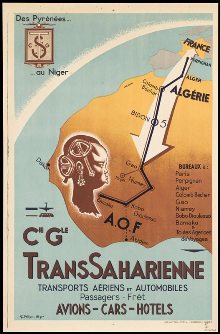Compagnie générale transsaharienne
 |
|
| Industry | Transport |
|---|---|
| Founded | 1923 |
| Defunct | June 1950 |
|
Area served
|
Sahara |
|
Key people
|
Gaston Gradis, Georges Estienne |
The Compagnie générale transsaharienne (CGT) was a French company founded in 1923 that provided road and air transport in the French colonial territories that covered most of the Sahara. It was acquired by a rival in June 1950.
The Compagnie Générale Transsaharienne (CGT) was founded on 23 May 1923. The founder was Gaston Gradis, president of the Nieuport-Astra airplane construction company and son-in-law of Henri Deutsch de la Meurthe, who had founded the first French airline, the Compagnie générale transaérienne. The retired General Jean Baptiste Eugène Estienne, who had designed and built tanks during the war, was made president of the company. The purpose of the company was to "study, establish and exploit land and air communications between the various territories of the African continent, particularly between Algeria and Niger." The company planned to provide land and air transport, including infrastructure and operations, for tourism and for topographic reconnaissance of the Mediterranean-Niger railroad project.
The company began with two exploratory voyages at the end of 1923 and the start of 1924. The first mission was led by lieutenant Georges Estienne, son of General Estienne, with his brother René and lieutenant Hubel, accompanied by four legionnaires and four Citroën mechanics. It travelled from Béni Ounif to Adrar, Algeria, and onward to Tessalit, then returned to Colomb-Béchar. Four Citroën cars with Kégresse tracks towed a Nieuport-Delage aircraft with folding wings covered by a huge white tarpaulin. The mission left Adrar on 17 November 1923, reached Tessalit on 30 November, and returned to Adrar on 13 December, having mapped a shorter route than those known before, over excellent terrain.
A second exploratory expedition left Colomb-Béchar at midnight on 25 January 1924, headed by Gaston Gradis, with three large six-wheel Renault cars with double tires. Gradis was accompanied by the Estienne brothers, M. Schwob, an engineer from Renault, and three mechanics. A rival Citroën expedition had left a day before, and the press made great play of the competition, which Gradis thought obscured the important goal of establishing a trans-Saharan route. After reaching Adrar the expedition left for the south in two vehicles, following the tracks of the November reconnaissance expedition, which were still visible. The six-wheel cars proved faster than the Citroën caterpillars. This expedition reached Gao, on the Niger River, and returned to Béchar on 1 March 1924. Gradis was optimistic about the potential for aerial travel along this route.
...
Wikipedia
